SUBSPECIALTY NEWS
Lucentis Study Shows Mixed Results
Visual Benefit Waned on As-Needed Dosing.
■ Recently-released results from the phase 3b HORIZON study indicate that even after 2 years of monthly injections of ranibizumab (Lucentis), wet AMD patients dosed on an as-needed basis in the third year on average lost about 5 letters of vision by the end of that year, though still maintaining a benefit of 4 letters compared to before they began receiving ranibizumab. In addition, patients who went untreated or received photodynamic therapy (PDT) for 2 years did not derive any significant benefit from ranibizumab in the third year.
"The 2 main takeaways from the HORIZON study are that the earlier we treat wet AMD patients, the better the results will be, and that, given the currently available therapies, we must view wet AMD as a chronic disease that must be continuously treated to maintain any vision gains," says Srinivas Sadda, MD, an investigator for the HORIZON study and associate professor of ophthalmology at the University of Southern California Keck School of Medicine in Los Angeles.
Dr. Sadda says that "the door remains open" for a new therapy that will be safe and provide a more durable response and require fewer injections.
"We don't like the prospect of giving patients eye injections every month," he says, particularly when it appears they may need them for many years. I used to think we could stabilize this disease with 2 years of aggressive treatment, but now it is clear that this is a chronic disease and we have to deal with it that way."
In the HORIZON study, 600 patients who had previously been injected with ranibizumab monthly for 2 years in the MARINA, ANCHOR or FOCUS trials were then switched to as-needed injections of the drug in the third year. After 2 years, they had averaged a vision gain of 9.4 letters, but after the third year that gain was reduced to 4.1 letters. These patients received an average of 3.2 injections of ranibizumab in the third year.
The 168 patients in what was termed the "cross-over" group received either sham injections or PDT for the first 2 years and an average of 3.7 ranibizumab injections in the third year. However, they averaged a 2.4 line loss of vision in the third year despite receiving ranibizumab. Patients who went totally untreated with ranibizumab for all 3 years averaged a 3.1 line loss of vision in the third year.
Data from the HORIZON study showed that repeated intravitreal injections were well tolerated and that incidence of adverse events was low and consistent with results from the pivotal phase 3 MARINA and ANCHOR ranibizumab studies.
Military Practice Has Rewards
Treating Combat Injuries Drives Innovation.
BY RÉNE LUTHE, SENIOR ASSOCIATE EDITOR
■ In his experience treating combat-related eye injuries from the wars in Iraq and Afghanistan, Air Force retina specialist Lt. Col. R. Gary Lane, MD, says that probably the most significant improvement he has seen involves intraocular foreign bodies (IOFBs) from blast injuries. "There's not a retinal surgeon in the theater, so we used to have to remove IOFBs right away — in the middle of the night, whenever the patient was brought in," Dr. Lane explains. He says that Eric D. Weichel, MD, director of vitreoretinal surgery at Walter Reed Army Medical Center, has had a series of "many dozens" of IOFBs where removal has been delayed for up to 2 weeks — without endophthalmitis setting in. "It's because the patients have been on antibiotics," Dr. Lane says. "Dr. Weichel has presented on that, and the finding is something new." And tremendously helpful, given the circumstances of an operating theater in a war zone, where there is no capability to do vitrectomy.
"Surgeons in Iraq and Afghanistan primarily close the eyes," Dr. Lane explains. "The medical evacuation system for these patients is very, very rapid, and most of them have other injuries — orthopedic injuries, neurosurgery injuries." The surgeons' goal, in this situation, is to stabilize patients, then get them to care in Germany, and then the United States within 24 to 48 hours. Performing retinal surgery before then might prohibit the patient from being flown out. "It's much better to just close the globe," Dr. Lane says. "If there's a foreign body in there, just leave it and get the patient back to the US, where they can get definitive care."

Dr. Lane (center) conducts ROP screening on a humanitarian mission to Nigeria.
Dr. Lane uses an endoscope to help with some of the more difficult trauma cases he sees at Wilford Hall Medical Center Ophthalmology Clinic in San Antonio, Texas. One successful technique is placing large posterior buckles for perforating injuries in the back of the globe. "We plan to present a paper on this at the AAO meeting next year," he says.
Treating combat-related trauma, however, is only part of what Dr. Lane does. While about one-third of his practice involves trauma, treating diabetes and AMD each comprise a third as well. He notes that his practice is similar to a civilian retina practice.
"I'm responsible for all of the active duty people, plus their spouses and children, and also all of our military retirees," he explains.
Diabetic retinopathy is a particular problem in San Antonio, he says. His work with the retinal staff at San Antonio's University Hospital has shown him the state of the local nonmilitary patient population's health. While the problems they face are similar, Dr. Lane is gratified to see that the care the military provides its patients translates to healthier results. "We see much less advanced proliferative diabetic retinopathy, because we do annual screening for everyone and we catch things much earlier, so we tend not to end up with these bad outcomes that you see elsewhere, where people don't see their doctors."
As the residency program director at Wilford Hall, Dr. Lane is also busy training residents. Any leftover time is spent on annual 2-week "goodwill" tours the military sponsors to provide eye care to countries in Central and South America. "Wilford Hall is one of the only places in the world that can perform pars plana vitrectomies in austere environments," Dr. Lane says.
With a few years left on his military commitment, Dr. Lane is considering his future. "I am interested in private practice," he says. But friends who have left the military tell him they miss the camaraderie the service offers. Not having to deal with insurance companies and coding are other bonuses of his current job. And there are the intangible benefits.
"I have patients who were in Normandy for D-Day, people who flew B-17 bombers in World War II, so it's very interesting," he says.
Whenever he encounters a veteran who has done something particularly intriguing, he tries to spend some extra time to listen to the stories.
"I enjoy our patients and there are a lot of things that are satisfying about a military practice. We have our headaches like everyone else, but there are unique advantages to it."
Radiation Shows Promise for Wet AMD
NeoVista Releases 18-Month Data.
■ NeoVista, Inc has announced encouraging 18-month data from its phase 2 feasibility study examining its novel epiretinal brachytherapy (radiation) for treatment of wet AMD.
The longer-term data from the study, which was initiated to test the safety and efficacy of the therapy when used in conjunction with bevacizumab, showed a marked advancement in mean visual acuity results (VA) at month 18, while only a limited number of patients required additional bevacizumab injections.
NeoVista's therapy applies a targeted dose of beta radiation to the leaking blood vessels that affect central vision; concomitantly, 2 injections of an anti-VEGF agent are delivered to maximize the acute therapeutic response. The company says that preliminary data show that targeted radiation therapy can be safe for both the patient and the physician, and may be able to restore some vision.
The ongoing multicenter feasibility study enrolled 34 trial participants (with a mean age of 72 years) from June 2006 to April 2007 at 2 centers in Brazil and 1 in Mexico. These patients, with predominantly classic, minimally classic, or occult choroidal neovascularization (CNV), received a single 24 Gy treatment of NeoVista's epiretinal brachytherapy in combination with 2 intravitreal injections of bevacizumab, 1 dose prior to or at the time of radiation delivery and another 1 month later, depending on the arm of the trial in which the patient was enrolled. Additional therapy was delivered based upon the investigator's evaluation of disease activity.
Analysis of 18-month follow-up on the first 25 trial participants to reach that milestone shows a mean improvement in VA of 10.7 letters using the Early Treatment Diabetic Retinopathy Study test; 96% of patients lost 15 letters or fewer, 76% gained some letters, 44% gained 15 or more letters, and 8% gained 30 or more letters. The company reports that 68% of the patients in the study did not require additional bevacizumab injections throughout the 18-month period and the average number of additional injections within this subset was 2.4 injections by month 18.
Most of the limited number of adverse events were related to the vitrectomy (retinal tear, retinal detachment, subretinal hemorrhage, and vitreous hemorrhage), rather than the epiretinal brachytherapy. To date, no instances of radiation toxicity have been reported.
In contrast to other forms of radiation therapy for wet AMD, NeoVista says its approach delivers the peak dose of energy directly to the lesion without damaging the normal retinal vasculature. Utilizing strontium 90, the focused energy is delivered to a target area up to 3 mm in depth and up to 5.4 mm in diameter. Systemic exposure to radiation is described as minimal.
| IN BRIEF |
|---|
| ■ Avastin shows durable response. Clinicians who have used both Avastin and Lucentis for the treatment of wet AMD have sometimes observed anecdotally that Avastin appears to have the more durable response. Whether this is true or not will be determined by the Comparisons of Age-Related Macular Degeneration Treatments (CATT) study, now underway. However, in a retrospective analysis of 68 patients treated with Avastin and 52 patients who received Lucentis, researchers led by Tom Chang, MD, of The Retina Institute of California, reported preliminary data at the recent American Society of Retinal Specialists meeting that showed mean remission time of 6.6 months for Avastin and 3.8 months for Lucentis. Monthly OCT measurement and clinical observations were used to determine the need for retreatment. All patients had 3 consecutive monthly injections – a standard induction protocol – before beginning the monitoring period. ■ Visudyne sales lag. QLT Inc reported that US sales of its wet AMD therapy Visudyne totaled $9.1 million in the 3 months ended Sept. 30, down almost 10% from the $10.1 million reported in the previous quarter and 2.9% from the prior-year third quarter. Sales outside the United States were $24.9 million, down 36.6% from the same quarter of the prior year. The drop in international Visudyne sales was primarily due to the approval and reimbursement in Europe of alternative therapeutics for wet AMD. ■ Lucentis sales increase. Genentech reported that worldwide sales for its wet AMD therapy Lucentis jumped to $225 million for the 3 months ended Sept. 30. This compares with $198 million in the same quarter a year ago and $216 million in the June quarter of this year. ■ Oral drug for Leber's Disease. QLT Inc has initiated a phase 1 safety study in healthy adults of QLT 091001, an orally administered synthetic retinoid replacement therapy for 11-cis-retinal, a key biochemical component of the visual retinoid cycle. The drug is being developed for the potential treatment of Leber's Congenital Amaurosis (LCA), an inherited progressive retinal degenerative disease that leads to retinal dysfunction and visual impairment beginning at birth. The phase 1 study is an open-label, single center, ascending-dose trial that will determine the safety and tolerance of multiple administrations of the synthetic retinoid drug in approximately 18 healthy adult volunteers. Participants will be enrolled in up to 6 cohorts of increasing doses. "We believe our retinoid synthetic program is a very interesting opportunity, as there are no currently available treatments for patients with LCA, which affects 1 in 100,000 newborns worldwide," said Bob Butchofsky, QLT president and CEO. "This program also supports the company's new ocular focus and we look forward to reporting the phase 1 data in the first half of 2009. We hope that our findings will support further clinical studies in this orphan indication." RP |








